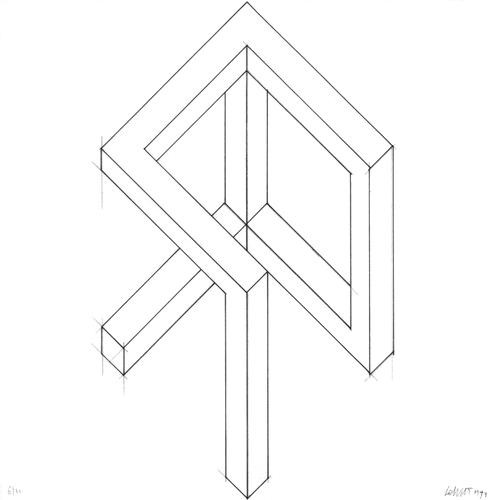
Schematic Drawing for Incomplete Open Cubes (1974)
[ink and pencil on vellum]
11. Ideas do not necessarily proceed in logical order. They may set one off in unexpected directions, but an idea must necessarily be completed in the mind before the next one is formed.
12. For each work of art that becomes physical there are many variations that do not.
13. A work of art may be understood as a conductor from the artist’s mind to the viewer’s. But it may never reach the viewer, or it may never leave the artist’s mind.
14. The words of one artist to another may induce an idea chain, if they share the same concept.
15. Since no form is intrinsically superior to another, the artist may use any form, from an expression of words (written or spoken) to physical reality, equally.
16. If words are used, and they proceed from ideas about art, then they are art and not literature; numbers are not mathematics.
17. All ideas are art if they are concerned with art and fall within the conventions of art.
18. One usually understands the art of the past by applying the convention of the present, thus misunderstanding the art of the past.
19. The conventions of art are altered by works of art.
20. Successful art changes our understanding of the conventions by altering our perceptions.
21. Perception of ideas leads to new ideas.
22. The artist cannot imagine his art, and cannot perceive it until it is complete.
23. The artist may misperceive (understand it differently from the artist) a work of art but still be set off in his own chain of thought by that misconstrual.
24. Perception is subjective.
25. The artist may not necessarily understand his own art. His perception is neither better nor worse than that of others.
26. An artist may perceive the art of others better than his own.
27. The concept of a work of art may involve the matter of the piece or the process in which it is made.
28. Once the idea of the piece is established in the artist’s mind and the final form is decided, the process is carried out blindly. There are many side effects that the artist cannot imagine. These may be used as ideas for new works.
29. The process is mechanical and should not be tampered with. It should run its course.
30. There are many elements involved in a work of art. The most important are the most obvious.
31. If an artist uses the same form in a group of works, and changes the material, one would assume the artist’s concept involved the material.
32. Banal ideas cannot be rescued by beautiful execution.
33. It is difficult to bungle a good idea.
34. When an artist learns his craft too well he makes slick art.
35. These sentences comment on art, but are not art.


1 response so far ↓
1 Raúl Rodríguez // Oct 2, 2010 at 7:41 PM
Even when these sentences are from 1969, with the large amount of conceptual art that is been produced today, they are still very accurate to judge a lot of contemporary art, and to be used by young conceptual artists to create an effective methodology to work with, which is why LeWitt’s art is still contemporary art, even when it has more than 30 years of created.
Leave a Comment